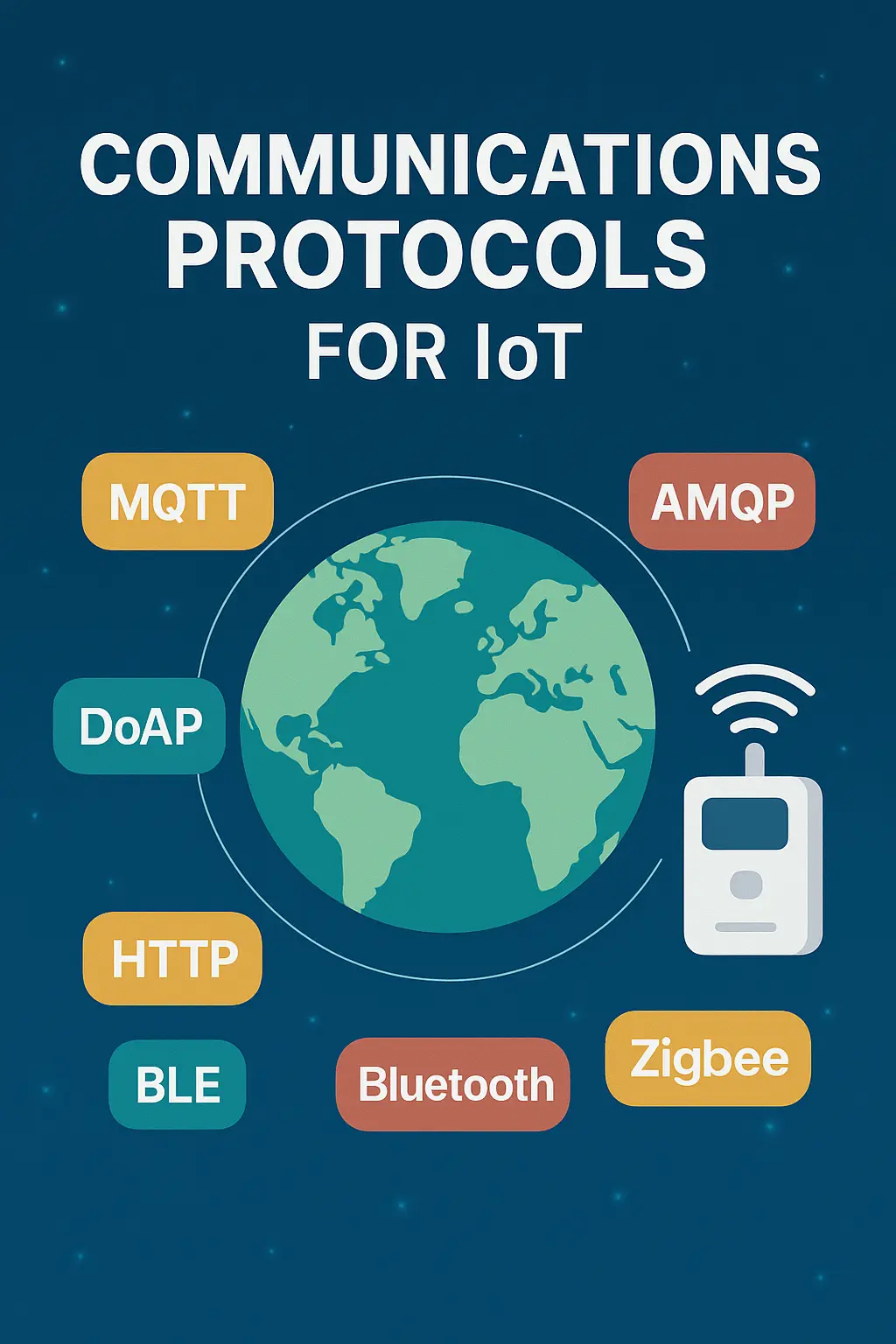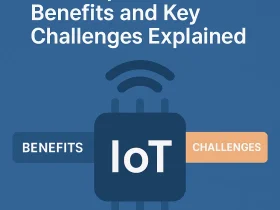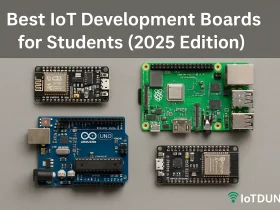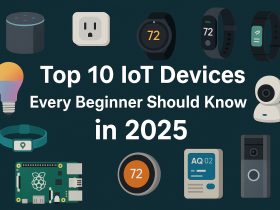Top Communication Protocols for IoT You Must Know
1. Introduction to IoT Communication
Imagine your smart light bulb turning on when your phone detects you’re near home. That’s IoT communication in action.
In an IoT system, sensors, devices, and cloud platforms need to talk — just like humans need a language. This “language” is called a communication protocol.
See also: Why Do We Need Internet of Things? Importance of IoT in 2025
2. What Are Communication Protocols for IoT?
In simple terms, communication protocols for IoT define how devices talk, share data, and understand each other.
These protocols set rules for:
- How data is packaged
- How it travels
- What to do if the message gets lost
- When to expect a reply
Analogy: Think of protocols as a set of traffic rules for IoT data. Without them, you’ll have data crashes and miscommunication chaos!
See more: Why We Need Protocols for Communication?
3. Why Do IoT Devices Need Different Protocols?
IoT devices come in all shapes and sizes — from a smartwatch on your wrist to a sensor on a farm.
Each has different needs:
| Device Type | Data Need | Power | Range | Ideal Protocol |
|---|---|---|---|---|
| Smartwatch | Low | Very Low | Short | Bluetooth Low Energy |
| Smart Light | Medium | Low | Medium | Zigbee |
| Weather Station (Rural) | Low | Very Low | Long | LoRaWAN |
| Industrial Robot | High | High | Wired | Ethernet, Modbus |
4. Classification of IoT Protocols (by Layer & Range)
a. OSI Layer-Based Classification
| Layer | Protocols |
|---|---|
| Physical & Data Link | Zigbee, BLE, Wi-Fi, LoRa, Modbus |
| Network | IPv6, 6LoWPAN, Thread |
| Transport | TCP, UDP |
| Application | MQTT, CoAP, HTTP, AMQP |

b. Range-Based Classification
| Range | Protocols |
|---|---|
| Short-range | Zigbee, BLE, NFC |
| Medium | Wi-Fi, 6LoWPAN |
| Long-range | LoRaWAN, NB-IoT, LTE-M |
5. Wireless Communication Protocols for IoT
5.1 MQTT – Message Queuing Telemetry Transport
Use: Cloud-based, lightweight IoT messaging protocol
Pattern: Publish / Subscribe
Example: Smart home devices sending data to a central hub

Why it’s great:
- Lightweight & efficient for low-power devices
- Works on unreliable networks
- Used by AWS IoT, IBM Watson
Diagram:
Sensor → MQTT Broker ←→ App / Dashboard
See more: MQTT Protocol in IoT: Complete Guide with Examples and Architecture (2025)
5.2 CoAP – Constrained Application Protocol
Use: REST-based protocol for low-power devices
Pattern: Request / Response (like HTTP)
Example: Remote health monitor asking patient device for data
Why it matters:
- Works over UDP (faster but less reliable)
- Lightweight for constrained devices
- Can be encrypted with DTLS
See more: What is CoAP Protocol in IoT? 2025 Guide for Beginners & Developers
5.3 Zigbee – IEEE 802.15.4 Based Mesh Protocol
Use: Secure, short-range mesh communication
Example: A smart light system where bulbs pass signals to each other
Key Benefits:
- Mesh network = resilient
- Very low power
- Fast data transfer within homes
Limitations:
- Limited range (10–100m)
- Needs coordinator
See more: What is Zigbee in IoT? Benefits & Applications Guide in 2025
5.4 LoRaWAN – Long Range Wide Area Network
Use: Remote sensing with low power
Example: Soil moisture sensors in farmlands
Pros:
- Communicates up to 15+ km
- Excellent for remote IoT
- Free spectrum (no SIM charges)
Cons:
- Low data rates
- Needs gateways
See more: What is LPWAN Technology? Uses, Examples & Full Guide 2025
5.5 BLE – Bluetooth Low Energy
Use: Short-range, ultra-low power IoT devices
Example: Fitness bands, smart locks
Features:
- Connects directly to phones
- Mesh possible via Bluetooth 5.0+
See more: Bluetooth vs Bluetooth Low Energy & Best Wireless IoT Protocol
5.6 NB-IoT & LTE-M – Cellular-Based LPWAN
Use: Massive IoT deployments over 4G networks
Example: Smart meters in urban cities
Highlights:
- Long-range with carrier support
- Excellent for cities
- Requires SIM card
See more: What is NB-IoT? Narrowband IoT Explained for Beginners 2025
6. Wired Communication Protocols for IoT
6.1 Ethernet
- Fast and reliable
- Used in smart factories and large setups
- Secure and constant power
6.2 Modbus / RS485
- Industry standard since 1970s
- Serial communication for PLCs
- Still used in SCADA, energy systems
6.3 CAN Bus
- Used in vehicles and robotics
- Real-time, fault-tolerant
- Also used in drones and industrial machines
7. How to Choose the Right Communication Protocol for IoT?

Choosing the right communication protocol for IoT isn’t just a technical decision — it’s a crucial step that affects the reliability, power efficiency, range, cost, and even the scalability of your IoT application. There’s no one-size-fits-all solution because different use cases demand different network behaviors.
Let’s break it down step-by-step using practical questions to guide your selection:
a. Do I need long-range communication?
If your devices are spread across a large area — like a farm, smart city, or logistics yard — you need a long-range, low-power communication method.
Best Options:
- LoRaWAN: Ideal for rural environments; it supports up to 15+ km range.
- NB-IoT (Narrowband IoT): Cellular-based LPWAN with strong indoor penetration and wide-area support.
Use Cases:
- Smart agriculture (soil moisture sensors, weather stations)
- Asset tracking across cities
- Water metering in remote areas
Avoid Wi-Fi or Zigbee here—they are short-range and not designed for wide-area IoT.
b. Will the device run on battery or solar power?
If your IoT device is battery-powered or solar-powered, conserving energy is critical. You’ll need ultra-low-power protocols that can wake up, transmit data quickly, and go back to sleep.
Best Options:
- Bluetooth Low Energy (BLE): Designed specifically for power efficiency in wearables and personal devices.
- Zigbee: Supports mesh networking while consuming minimal energy.
Use Cases:
- Wearables like fitness trackers
- Smart lighting systems
- Battery-operated smart locks and thermostats
Tip: Avoid traditional Bluetooth or Wi-Fi unless your device is constantly plugged in or has a high-capacity battery.
c. Do I need cloud or internet connectivity?
If your project involves sending data to a remote server, cloud dashboard, or mobile app, you need a protocol that’s cloud-ready and reliable over the internet.
Best Options:
- MQTT: Lightweight publish-subscribe protocol, perfect for low-bandwidth and high-latency networks
- CoAP (Constrained Application Protocol): Ideal for REST-based cloud APIs in resource-constrained environments
Use Cases:
- Real-time IoT dashboards (home automation, weather stations)
- Smart appliances that send usage stats to the cloud
- Smart cities collecting and analyzing public data
Did You Know?
Both MQTT and CoAP are application layer protocols but differ in their transport method — MQTT uses TCP, while CoAP uses UDP.
d. Do I want real-time control or deterministic communication?
In industrial IoT or automotive applications, there’s a need for deterministic, low-latency control over actuators, robots, and machinery. Here, reliability and timing are more important than power savings.
Best Options:
- CAN (Controller Area Network): Widely used in automotive and robotics for real-time, fault-tolerant communication.
- Ethernet: Offers high-speed, wired communication for local networks; suitable for factory automation and SCADA systems.
Use Cases:
- Manufacturing robots on an assembly line
- Automated guided vehicles (AGVs) in warehouses
- Smart grids and building management systems
Pro Tip: If you’re dealing with motors, servos, or safety-critical systems, prioritize deterministic protocols like CAN.
Summary Decision Guide
| Requirement | Recommended Protocols | Why It Works |
|---|---|---|
| Long-Range Coverage | LoRaWAN, NB-IoT | Wide area, low power, rural-friendly |
| Battery Powered Device | BLE, Zigbee | Ultra-low energy, mesh or personal use |
| Cloud Connectivity | MQTT, CoAP | Lightweight, cloud-optimized |
| Real-Time Control | CAN, Ethernet | Deterministic and reliable |
Bonus Considerations:
- Security Requirements: Zigbee and LoRaWAN support encryption by default; MQTT needs TLS for secure transport.
- Network Topology: Mesh (Zigbee), Star (LoRaWAN), Point-to-Point (Bluetooth).
- Scalability: NB-IoT and MQTT scale well to thousands of devices.
- Cost: Wi-Fi and BLE modules are generally cheaper; cellular-based NB-IoT may incur SIM and subscription fees.
Still Not Sure? Ask Yourself:
- Will the device be stationary or mobile?
- Is there line-of-sight between sender and receiver?
- Is data loss acceptable, or do I need full reliability?
- Do I need bidirectional communication or just sensing?
By answering these, you’ll have a clear picture of the best communication protocol for your IoT project — tailored to its environment, use case, and budget.
8. Security in Communication Protocols for IoT
| Protocol | Security Feature |
|---|---|
| MQTT | TLS encryption |
| CoAP | DTLS encryption |
| Zigbee | AES 128-bit encryption |
| LoRaWAN | End-to-end encryption |
| NB-IoT | Operator-grade authentication |
Tip: Always validate and encrypt data before sending.
9. Future Trends in Communication Protocols for IoT (2025–2030)

As the Internet of Things continues to evolve, so will the communication protocols that power it. Between 2025 and 2030, several technological shifts are poised to reshape how IoT devices talk to each other—bringing faster data rates, stronger security, and better compatibility across platforms.
Let’s dive into the most significant trends you’ll see emerging in IoT communication protocols:
a. 5G IoT Integration with Ultra-Low Latency
5G is not just about faster mobile internet — it’s a game-changer for IoT.
- What changes? Traditional IoT protocols like LTE-M or NB-IoT will begin merging with 5G’s architecture. New 5G-based IoT protocols will support enhanced URLLC (Ultra-Reliable Low Latency Communication) for mission-critical systems.
- Impact on IoT Protocols:
- Real-time applications like autonomous vehicles, robotics, and remote surgeries will rely on 5G slices.
- Edge devices will offload more data to base stations with near-zero lag.
- Use Cases: Smart manufacturing, smart grids, connected vehicles, AR/VR in IoT.
Imagine a factory robot receiving commands in milliseconds, reducing downtime and improving safety — that’s 5G IoT in action.
b. Quantum-Safe Protocols for Critical IoT Infrastructure
As quantum computing matures, many current encryption techniques used in protocols like TLS (in MQTT) or DTLS (in CoAP) may become vulnerable.
- Why it’s important: IoT infrastructure in defense, finance, and national utilities needs to be future-proof.
- What’s coming:
- Quantum-Resistant Encryption: Algorithms that can withstand decryption attempts from quantum computers.
- Post-Quantum IoT Protocols: Lightweight, crypto-resilient versions of MQTT, AMQP, and HTTPS.
- Use Cases: Government IoT networks, smart military equipment, and energy grids.
The shift to quantum-safe protocols will be as crucial as moving from HTTP to HTTPS for IoT security in the coming decade.
c. Interoperable Standards Like Matter for Smart Homes
Fragmentation has been a major issue in the smart home ecosystem — Zigbee, Z-Wave, Wi-Fi, and proprietary protocols often don’t work together.
- Enter Matter: An open-source standard backed by Google, Apple, Amazon, and the Connectivity Standards Alliance (CSA).
- What Matter enables:
- A universal communication layer that sits on top of existing protocols like Thread, Wi-Fi, BLE.
- Ensures that smart home devices from different brands communicate seamlessly.
- Impact on Protocol Design:
- Protocols will prioritize cross-compatibility over brand exclusivity.
- Devices will auto-negotiate the best protocol for the task.
- Use Cases: Smart lighting, door locks, thermostats, and voice assistants.
In a Matter-based world, your Apple HomePod, Google Nest, and Amazon Alexa can finally “speak” the same language.
d. AI-Optimized Communication Routing
As the number of IoT devices grows exponentially, network congestion and latency become major issues.
- What AI brings to the table:
- Dynamic routing decisions based on device behavior, location, and data priority.
- Predictive maintenance and self-healing networks.
- Protocols will evolve to:
- Integrate machine learning at the edge.
- Select the best transport protocol dynamically (e.g., switch between MQTT and CoAP based on network load).
- Use Cases: Smart cities, intelligent transport systems, and industrial IoT.
AI will become the digital brain of IoT networks, automatically managing traffic and avoiding bottlenecks in real time.
e. IPv6 Adoption for Massive IoT Scaling
IoT is running out of room to grow on IPv4.
- Problem: IPv4 can only support ~4.3 billion devices, many already taken.
- Solution: IPv6, with 340 undecillion (3.4×10^38) addresses, is designed for the scale of IoT.
- Why it’s critical:
- Every sensor, actuator, and microcontroller can now have a unique IP.
- Simplifies direct device-to-device communication without NAT (Network Address Translation).
- Impact on Protocols:
- Protocols like 6LoWPAN will see wider adoption for low-power IPv6 networking.
- Native IPv6 support will become a default requirement in upcoming devices and firmware.
IPv6 is the foundation for truly global and decentralized IoT networks — no middlemen, just smart devices directly talking to each other.
These trends will shape how IoT devices interact, scale, and secure themselves in the next 5–10 years. Protocols won’t just be technical specs anymore — they’ll become adaptive ecosystems, driven by AI, secured against quantum threats, and unified under global standards like Matter and IPv6.
See also: MQTT vs CoAP: Detailed Comparison of Two Leading IoT Protocols in 2025
Frequently Asked Questions (FAQs)
1. What are communication protocols for IoT?
Communication protocols for IoT are a set of rules that define how IoT devices exchange data over a network. They ensure devices can send, receive, and interpret data correctly, even across different platforms and technologies.
2. Why do IoT devices need different communication protocols?
IoT devices have varying needs—some run on batteries, some are stationary, some need long-range communication, and others require high-speed data. Protocols like MQTT, Zigbee, LoRaWAN, and BLE are tailored for specific conditions like low power, short range, or cloud connectivity.
3. Which protocol is best for long-range communication in IoT?
For long-range, low-power communication, LoRaWAN and NB-IoT are widely used. They are ideal for applications like agriculture, smart cities, and remote monitoring where devices are far apart and need to conserve energy.
4. Is MQTT better than CoAP?
It depends on your use case. MQTT is ideal for cloud-based publish/subscribe messaging over TCP, making it great for real-time data streaming. CoAP, on the other hand, works well in constrained devices using UDP and follows a REST architecture, suitable for lightweight, request/response communications.
5. Can I use Wi-Fi for IoT devices?
Yes, Wi-Fi is commonly used for high-bandwidth IoT applications like smart cameras or voice assistants. However, it consumes more power compared to protocols like Zigbee or BLE, which are more suitable for low-power, low-data-rate devices.
6. What is the most secure IoT communication protocol?
Security depends on implementation, but most modern protocols include built-in protection:
- MQTT: Supports TLS encryption
- CoAP: Uses DTLS for secure transmission
- Zigbee: Includes AES-128 encryption
- LoRaWAN: Provides end-to-end AES encryption
Always combine protocol-level security with secure device and cloud configurations for best results.
7. How do I choose the right communication protocol for my IoT project?
Ask yourself:
- Do I need long-range communication?
- Is power consumption a concern?
- Will the device connect to the cloud?
- What’s the required data speed?
Based on these answers:
- Use LoRaWAN/NB-IoT for long-range low-power use.
- Use MQTT for cloud-based applications.
- Use Zigbee/BLE for mesh or short-range low-energy applications.
- Use Modbus/Ethernet for industrial use.
See also: MQTT vs HTTP: Which IoT Protocol is Better in 2025?
Conclusion
Communication protocols are the invisible glue holding the Internet of Things together. From a smart home device to an industrial sensor — choosing the right communication protocol for IoT can make or break your project.
- Need cloud-based messaging? Go for MQTT.
- Want efficient smart home networks? Use Zigbee.
- Deploying rural sensors? Pick LoRaWAN.
- Industrial control? Stick with Ethernet or Modbus.
See also: Top Components of IoT for Building Smart Projects 2025
Ready to Explore More? Let’s Build Smarter Together!
🔔 Subscribe to Our YouTube Channel » for IoT video Tutorials.
🌐 Start Learning IoT Basics Now » and What is IoT? – Introduction to IoT and IoT Architecture: 4 Essential IoT Layers Simplified for Beginners on IoTDunia.com! and Check out Top IoT Applications in Real World – Smart Use Cases 2025, IoT career guide 2025, Best Projects on IoT for Beginners
👉 Have questions? Drop them in the comments!
💡 Start small, stay curious, and make your world smarter—one device at a time.










Leave a Review